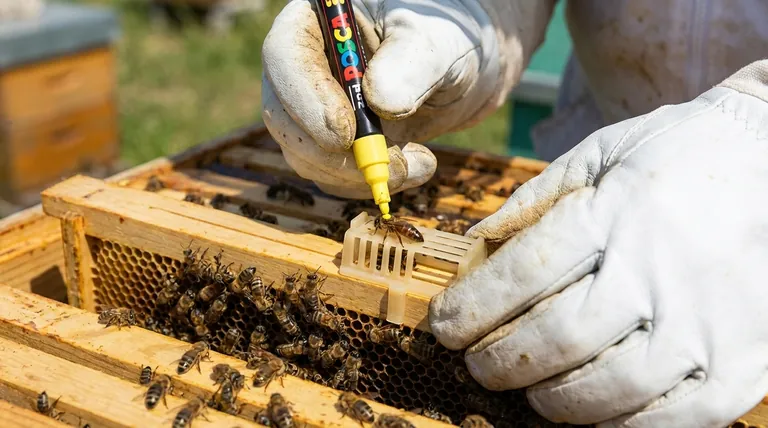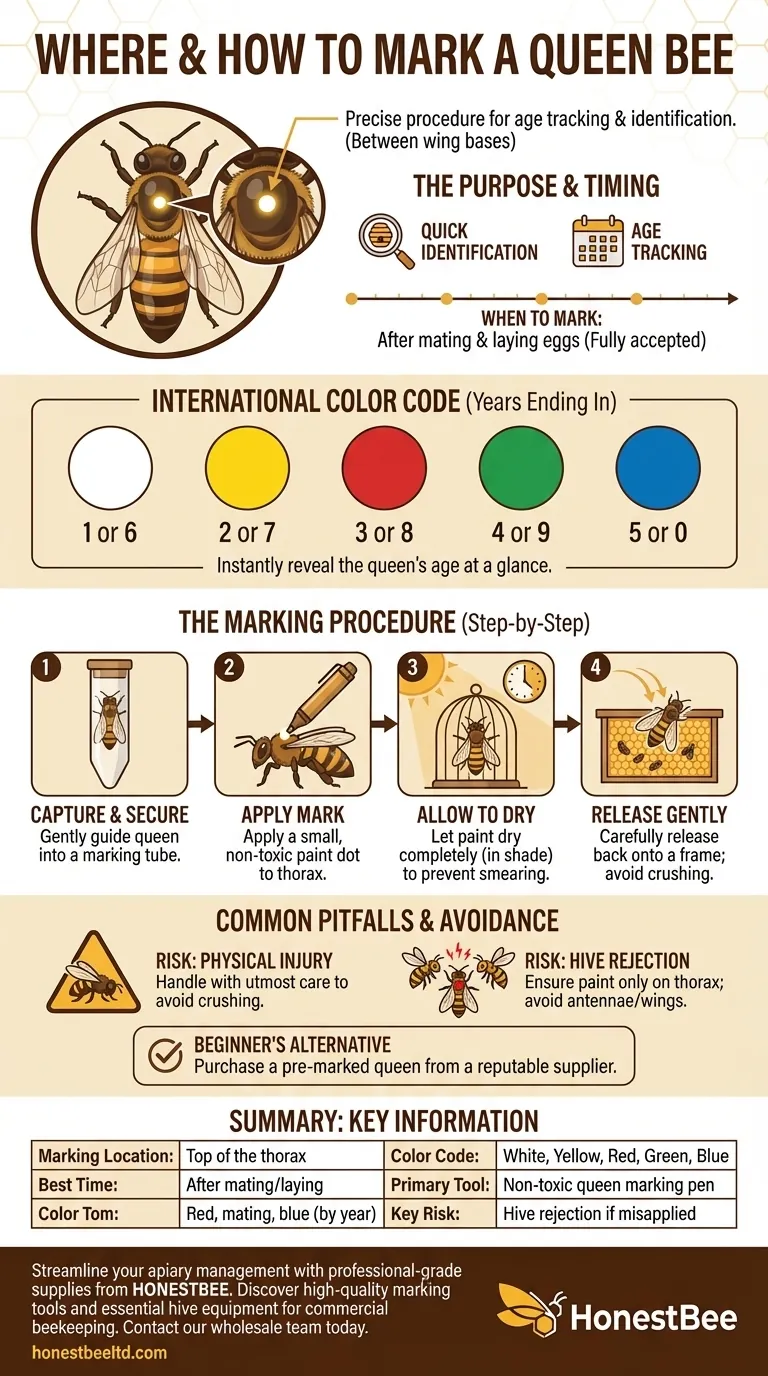To mark a queen bee, you apply a small dot of non-toxic paint to the top of her thorax, the middle section of her body. This spot is located directly between the points where her wings connect, which is a hard, bald area that will not be harmed by the paint.
Marking a queen is more than just applying a dot of paint; it is a precise procedure that allows beekeepers to instantly identify a queen's age and presence. The true challenge lies not in where to mark her, but in handling her safely to prevent injury or rejection by the hive.

The Purpose and Timing of Marking
Marking a queen bee serves two primary functions for a beekeeper: quick identification and age tracking. A marked queen is easy to spot among thousands of other bees, confirming the hive is "queenright." The color of the mark also instantly reveals the year she was born.
When to Mark a Queen
The best time to mark a queen is after she has completed her mating flights and has started laying eggs. This ensures she is fertile and has been accepted as the hive's leader.
If you are introducing a new, unmarked queen, wait until the colony has fully accepted her and she has settled into a consistent laying pattern. Always choose a calm, clear day with good weather to minimize stress on both the bees and the beekeeper.
The International Color Code
Beekeepers use an international color code to track the queen's age. The color corresponds to the last digit of the year she was hatched or introduced.
- White: Years ending in 1 or 6
- Yellow: Years ending in 2 or 7
- Red: Years ending in 3 or 8
- Green: Years ending in 4 or 9
- Blue: Years ending in 5 or 0
Using this system allows you to know a queen's age at a glance, which is critical for deciding when she may need to be replaced.
The Marking Procedure: A Step-by-Step Guide
The process requires a steady hand and the right equipment. The goal is to be as quick and gentle as possible.
Essential Tools
You will need a queen marking pen, which is a non-toxic, water-based paint marker. You will also need a queen marking tube or cage to safely hold her still during the process.
Step 1: Find and Capture the Queen
Carefully inspect the brood frames to locate the queen. Once found, gently guide her into your marking tube or cage. These tools are designed to hold her securely without applying harmful pressure.
Step 2: Apply the Mark
With the queen secured, gently press the marking pen onto the top of her thorax to apply a small, clear dot of paint. Be precise and use minimal paint.
Step 3: Allow the Paint to Dry
Keep the queen safely confined in the shade for a few minutes while the paint dries completely. Wet paint can rub off onto other bees, which can cause confusion or lead to the queen being harmed.
Step 4: Release the Queen
Once the paint is dry, gently release the queen back onto the surface of a brood frame. Carefully place the frame back into the hive, making sure not to crush or "roll" her between frames.
Common Pitfalls and How to Avoid Them
Marking a queen carries inherent risks. Understanding these dangers is key to performing the task successfully.
The Risk of Physical Injury
The queen is fragile. Applying too much pressure when capturing or holding her can crush her. Handle her with the utmost care at all times.
The Risk of Hive Rejection
This is the most significant risk. If paint gets on her antennae, eyes, or wings, the other bees may perceive her as damaged or foreign and attempt to kill and replace her. Precision is paramount. A clean mark on the thorax is the only acceptable outcome.
The Beginner's Alternative: A Pre-Marked Queen
For new beekeepers, the easiest and safest option is to purchase a pre-marked queen from a reputable supplier. This eliminates the risk of harming a valuable queen and allows you to focus on other aspects of hive management.
Making the Right Choice for Your Goal
Your approach to queen marking should align with your experience level and management goals.
- If your primary focus is learning and minimizing risk: Purchase a pre-marked queen from your supplier to avoid the potential for a costly mistake.
- If your primary focus is tracking hive genetics and age: Mark the queen yourself using the correct international color code after she is well-established and laying eggs.
- If your primary focus is safety during the marking process: Use a dedicated marking tube and ensure the paint is completely dry before releasing the queen back onto a frame.
Properly marking your queen is a fundamental skill that transforms hive inspections from a search party into a quick, efficient assessment.
Summary Table:
| Topic | Key Information |
|---|---|
| Marking Location | Top of the thorax, between wing bases. |
| Best Time to Mark | After mating flights, when she is laying eggs. |
| International Color Code | White (1/6), Yellow (2/7), Red (3/8), Green (4/9), Blue (5/0). |
| Primary Tool | Non-toxic queen marking pen. |
| Key Risk | Hive rejection if paint gets on antennae, eyes, or wings. |
Streamline your apiary management with professional-grade supplies from HONESTBEE.
As a commercial beekeeper or equipment distributor, efficiency and precision are paramount. Properly marked queens are essential for tracking hive health and productivity. HONESTBEE supplies the durable, reliable beekeeping equipment and wholesale supplies you need to manage your operations successfully—from high-quality marking tubes to essential hive tools.
Contact our wholesale team today to discuss your specific needs and discover how our products can support the growth and efficiency of your business.
Visual Guide

Related Products
- Queen Bee Marking Pen POSCA Queen Marking Pens for Beekeeping Bee Markers
- Queen Bee Marking Pen UNI Medium Point for Queen and Bee Marking
- Queen Bee Marking Tube Cage Bottle Catcher Holder with Clear Plastic Plunger Marker
- Professional Engraved Round Hive Number Tags for Beekeeping
- Professional Galvanized Hive Strap with Secure Locking Buckle for Beekeeping
People Also Ask
- What are the Queen marking colors associated with specific years? Master Hive Management with the 5-Year Color Code
- What are the advantages of marking a queen bee? Achieve Precision and Confidence in Hive Management
- What is the purpose of a queen marking pen in beekeeping? Essential for Efficient Hive Management
- What type of markers are commonly used for marking Queen bees? Choose the Safe, Non-Toxic Standard
- What are the benefits of learning to mark your own queen bees? Boost Your Apiary's Efficiency and Confidence



















